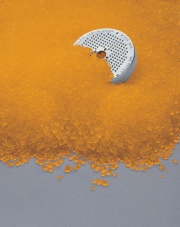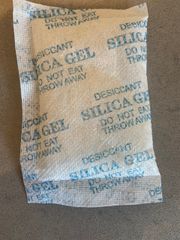Silica gel
Description
An amorphous material of Silica available as granules, powder of beads. Silica gel is chemically inert, very porous, and hygroscopic. It has an internal network of interconnecting microscopic pores, yielding a typical surface area of 700-800 square meters per gram. First patented in 1919, for use in gas mask, silica gel adsorbs pollutants as well as water. It is used as a dessicant, pollutant sorbent and as a humidity buffering agent. Silica gel absorbs moisture in humid environments and releases water in dry air. Once equilibrated to set moisture level, silica gel will maintain that humidity level in a closed environment.
Examples of silica gel products preconditioned as humidity buffers are Art-Sorb®, Arten gel and PROsorb. Silica gel that is saturated with water can regenerated with heat (120 C for 2 hours) and used again. Some brands of commercial silica gel include cobalt chloride as a humidity indicator (blue when dry and pink when moist). Silica gel has also been used as a Desiccant in Dri-die cockroach formulation.
- See also Silica gel, commercial.
Synonyms and Related Terms
amorphous silica; gel de silice (Fr.); dessicant
Brand names: Britesorb [PQ Corp.]; Dri-die; Art-Sorb® [Fuji Silysia]; GORE-TEX® silica tiles; Arten gel; Arten tiles; Aerosil; Prosorb, Rhapid Gel; Rhapid Pak; Scavengel
Personal Risks
- Noncombustible
- Hygroscopic
- Contact may cause irritation
- Cobalt chloride is toxic
- ThermoFisher: SDS
Resources and Citations
- AIC Conservation Wiki: Exhibit Technical Notes: Environmental Control
- Exhibit Guidelines Technical Note: Silica Gel Products and How to Use Them
- Exhibit Guidelines Technical Note: Conditioning Silica Gel
- Exhibit Guidelines Technical Note: Conditioning Silica Gel with a Saturated Salt Solution
- J.Tétreault, P.Bégin, Silica Gel: Passive Control of Relative Humidity, CCI Technical Bulletin no. 32. Canadian Conservation Institute. Ottawa (2017).
- Art Preservation Services: Silica Gel Technical Information
- S. Weintraub, "Demystifying silica gel", Objects Specialty Group Postprints, Vol.9, p. 169-194, 2002 Link
- R. Lafontaine, "Silica Gel", Technical Bulletin No. 10, Canadian Conservation Institute, October 1984
- G.S.Brady, Materials Handbook, McGraw-Hill Book Co., New York, 1971 Comment: p. 710
- Ralph Mayer, A Dictionary of Art Terms and Techniques, Harper and Row Publishers, New York, 1969 (also 1945 printing)
- Marjorie Shelley, The Care and Handling of Art Objects, The Metropolitan Museum, New York, 1987
- Richard S. Lewis, Hawley's Condensed Chemical Dictionary, Van Nostrand Reinhold, New York, 10th ed., 1993
- Hermann Kuhn, Conservation and Restoration of Works of Art and Antiquities, Butterworths, London, 1986
- Lynda A. Zycherman, J.Richard Schrock, A Guide to Museum Pest Control, FAIC and Association of Systematics Collections, Washington DC, 1988
- Matte Paint: Its history and technology, analysis, properties and conservation treatment, Eric Hansen, Sue Walston, Mitchell Bishop (ed.), J. Paul Getty Trust, Los Angeles, Vol. 30 of AATA, 1993
- Matt Roberts, Don Etherington, Bookbinding and the Conservation of Books: a Dictionary of Descriptive Terminology, U.S. Government Printing Office, Washington DC, 1982
- Pam Hatchfield, Pollutants in the Museum Environment, Archetype Press, London, 2002
- Marie Svoboda, Conservation Survey Index, unpublished, 1997
- A Glossary of Paper Conservation Terms, Margaret Ellis (ed.), Conservation Center of the Institute of Fine Arts, New York City, 1998
- AMOL reCollections Glossary -http://amol.org.au/recollections/7/c/htm

